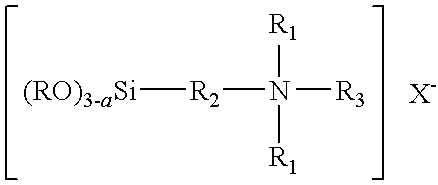Stable aqueous solutions of silane quat ammonium compounds
a technology aqueous solutions, which is applied in the field of stable aqueous solutions of silane quat ammonium compounds, can solve the problems of increasing exposure to mold, destroying the area on which the spores grow, and adverse health effects and symptoms, so as to prevent mold formation, stable shelf life, and easy application to any surface
- Summary
- Abstract
- Description
- Claims
- Application Information
AI Technical Summary
Benefits of technology
Problems solved by technology
Method used
Image
Examples
example 1
[0052]A composition was prepared comprising:
[0053]1.0% AEM 57721 (Aegis Antimicrobial agent)
[0054]0.05% Zonyl FSH (fluorsurfactant)
[0055]0.1% Sasol 23 E7 (ethoxylated alcohol)
[0056]98.85% Water
[0057]1. AEM 5772 is a composition as follows (all amounts are % by weight):[0058]12% Methanol[0059]72% 3-(trihydroxysilyl)propyldimethyl-octadecyl ammonium chloride[0060]15% Chloropropyl trimethyl silanol[0061]1% Dimethyl C18 amine
[0062]The composition was applied to surfaces of the following: stainless steel, aluminum, wood, glazed tile, unglazed tile, glass, and vinyl siding. To facilitate drying, the coated articles were placed in an oven at about 122° F. The articles were taken out of the oven, cooled and rinsed with water. Each surface was coated with bromophenol blue in order to determine if the silane quat was bonded to the surface. Each coated surface turned blue, which indicated that the silane quat was bonded to the surface.
example 2
[0063]A composition was prepared comprising:
[0064]1.0% AEM 5772 (Aegis Antimicrobial agent)
[0065]0.5% Sodium Bicarbonate
[0066]2.0% Hexyl Carbitol (diethylene glycol hexyl ether)
[0067]96.50% Water
[0068]The composition was applied to surfaces of the following: stainless steel, aluminum, wood, glazed tile, unglazed tile, glass, and vinyl siding. To facilitate drying, the coated articles were placed in an oven at about 122° F. The articles were taken out of the oven, cooled and rinsed with water. Each surface was coated with bromophenol blue in order to determine if the silane quat was bonded to the surface. Each coated surface turned blue, which indicated that the silane quat was bonded to the surface. The use of sodium bicarbonate accelerates the activity of the composition and aids in the binding of the silane quat to the surfaces.
example 3
[0069]A composition was prepared comprising:
[0070]1.0% AEM 5772 (Aegis Antimicrobial agent)
[0071]0.25% Sodium Bicarbonate
[0072]1.25% Hexyl Carbitol (diethylene glycol hexyl ether)
[0073]97.50% Water
[0074]The composition was applied to surfaces of the following: stainless steel, aluminum, wood, glazed tile, unglazed tile, glass, and vinyl siding. To facilitate drying, the coated articles were placed in an over at about 122° F. The articles were taken out of the oven, cooled and rinsed with water. Each surface was coated with bromophenol blue in order to determine if the silane quat was bonded to the surface. Each coated surface turned blue, which indicated that the silane quat was bonded to the surface.
PUM
 Login to View More
Login to View More Abstract
Description
Claims
Application Information
 Login to View More
Login to View More - R&D
- Intellectual Property
- Life Sciences
- Materials
- Tech Scout
- Unparalleled Data Quality
- Higher Quality Content
- 60% Fewer Hallucinations
Browse by: Latest US Patents, China's latest patents, Technical Efficacy Thesaurus, Application Domain, Technology Topic, Popular Technical Reports.
© 2025 PatSnap. All rights reserved.Legal|Privacy policy|Modern Slavery Act Transparency Statement|Sitemap|About US| Contact US: help@patsnap.com

